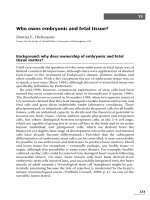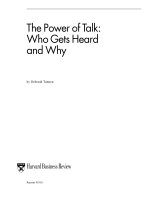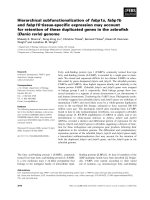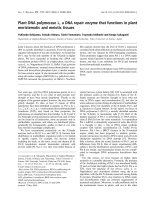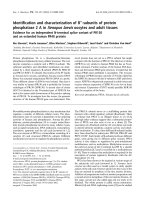Who owns embryonic and fetal tissue
Bạn đang xem bản rút gọn của tài liệu. Xem và tải ngay bản đầy đủ của tài liệu tại đây (150.86 KB, 14 trang )
15
Who owns embryonic and fetal tissue?
Donna L. Dickenson
Centre for the Study of Global Ethics, University of Birmingham, UK
Background: why does ownership of embryonic and fetal
tissue matter?
Until very recently the question of who owns embryonic or fetal tissue was of
limited commercial importance, although there were applications of aborted
fetal tissue in the treatment of Parkinson’s disease, diabetes mellitus and
other conditions. With a few exceptions the use of embryonic tissue was, so
to speak, a non-issue (Boer, 1994), although the use of ovarian fetal tissue was
speciWcally forbidden by Parliament.
By mid-1999, however, commercial exploitation of stem cells had been
termed the most controversial ethical issue in biomedicine (Capron, 1999).
The threshold event occurred in November 1998, when two separate teams of
US scientists claimed that they had managed to isolate human embryonic and
fetal cells and grow them indeWnitely under laboratory conditions. These
pluripotent and/or totipotent cells are eVectively the parent cells for all bodily
tissues, with an unlimited capacity to divide and the theoretical potential to
become any body tissue. (Some authors equate pluripotent and totipotent
cells, but others distinguish between totipotent cells, at the 2–4 cell stage,
which are capable of giving rise to every cell line in the body and to an entire
human individual, and pluripotent cells, which are derived from the
blastocyst at a slightly later stage of development, when the outer and internal
cells have already become diVerentiated.) Provided that the subsequent
diVerentiation of embryonic stem cells can be controlled, it may conceivably
be possible to use embryonic and fetal tissue to produce bone marrow, blood
and brain tissue for transplant – eventually perhaps, any bodily tissue or
organ, although this possibility is some years distant. For example, healthy
cultured cardiac cells could be injected into damaged heart muscle following
myocardial infarct. (In mice, heart muscle cells have been derived from
embryonic stem cells injected into, and successfully integrated with, the heart
muscle of adult animals.) Neurological stem cell transplants might be par-
ticularly promising because the risk of rejection is moderated by the brain’s
unique immunological status (NuYeld Council, 2000: p. 4). As one of the
scientiWc teams stated,
233
We could make universal donors. More speciWc cells could become transplant thera-
pies for diabetes, spinal cord injury, neurodegenerative disorders like Parkinson’s
disease, muscular dystrophies, arteriosclerosis and wound healing.
The use of stem cells would also streamline pharmaceutical testing; new drugs
could be tested for safety and eYcacy on cultured stem cells before being
tested in humans. Thus pharmaceutical and biotechnology Wrms are hugely
interested in the use of such cultured cells and in the development of tissue
banks of both undiVerentiated and specialized cells and tissues. Six to eight
pluripotent cell lines have already been developed, in the US and Singapore,
although some estimates (as of July 2001) cite up to 30 worldwide (Phillips,
2001). Eventually the need for embryo ‘donations’ should lessen as the self-
replicating stem-cell lines grow in size. But does this mean that the ethical
issues will disappear? Hardly. The enormous commercial value of these cell
lines, which will increase with their size, raises profound issues of justice and
exploitation, particularly issues of property rights.
Both the US teams were funded by the Geron Corporation, an American
biotechnology company which is now seeking a patent on the technologies.
At the time of writing, late in 2000, the UK’s Roslin Institute, which produced
the Dolly cloning technique, was reported to be exploring collaboration with
the Wisconsin researchers, with a view towards deriving cells from adult
patients that could be cloned using isolated embryonic stem cells. The aim is
to develop cell therapy rather than manufacturing tissues and organs, with
the advantage of avoiding immunological rejection problems. By a remark-
able coincidence, the Geron Corporation also has a major interest in the
commercial arm of the Roslin Institute. The globalization of stem cell
research and application is already upon us. It will almost certainly mush-
room into an international trade in embryonic stem cells. German research
groups already are using embryonic stem cells imported from other ‘less
moral’ countries such as Denmark, Finland, Spain, Sweden and the UK, since
the German Embryo Protection Act of 1990 prohibits any retrieval of cells
from embryos, under criminal penalties (Lunshof, 2000).
One of the US teams, based at the University of Wisconsin, produced their
cells from blastocysts developed in vitro as part of infertility treatment. The
second team, from Johns Hopkins, used what they called primordial germ
cells, which would eventually have become gametes. Interest has mainly
focused on embryonic stem cells (ES cells) rather than embyronic germ cells
(EG cells), where attempts to derive adult cells in mice have led to abnormali-
ties. Use of ES cells has also been assumed to be less ethically debatable,
because it does not require abortion, or because pre-embryos are thought to
have a lesser moral status than fetuses. I think it is far from obvious, however,
that use of ES cells is ethically trouble-free; that is because I shall focus not on
the status of the fetus/embryo, but on the rights of the mother.
The Wisconsin method uses embryos grown in vitro, developed through
234 D.L. Dickenson
fertilization of the mother’s ova with the father’s sperm – primarily ‘spare’
embryos which are not to be implanted. (It would also be possible to create
embryos from gametes ‘harvested’ expressly for this purpose.) Stem cells are
derived from the inner cell mass of the blastocysts; the outer cellular layer,
which would normally develop into the placenta, is dissolved. Since the
blastocysts are used before implantation, the mother’s ‘sweat equity’ is
reduced, but she has still undergone the labour of stimulation with fertility
drugs (superovulation) and extraction of ova – painful and moderately risky
procedures.
The Johns Hopkins method of using primordial gamete cells relies on
aborted fetal tissue, into which the mother has put the labour of early
pregnancy. John Gearhart’s team at Johns Hopkins derived stem cells from
primordial germ (gonadal) cells of fetuses aborted Wve to nine weeks after
fertilization. Oddly, although using aborted fetuses might appear to be the
more ethically and legally controversial of the two methods, the Hopkins
technique does not contravene federal restrictions, whereas limitations have
been imposed on the use of the Wisconsin method. The ethically signiWcant
diVerence seems to be that life is not deliberately created in the Hopkins case,
as by the admixture of gametes to form early-stage embryos, and the fetus is
dead before research starts, even if the cells are still alive. In the Wisconsin
method, the embryo is eVectively killed by removal of the outer layer of the
blastocyst (Capron, 1999).
Although the two techniques raise separate moral and legal questions,
commentators have united in approaching both of them almost solely
through focusing on the moral status of the embryo or fetus. So far as the
mother (and sometimes father) are concerned, the only legal and ethical
issues are usually held to concern the quality of consent to further uses of the
embryonic and fetal tissue. For example, the NuYeld Council on Bioethics
group (2000: p. 1) concluded that ‘the removal and cultivation of cells from a
donated embryo does not indicate lack of respect for the embryo’. UK
Parliamentary debate before the Human Fertilisation and Embryology (HFE)
Act of 1990 had culminated in agreement that embryo research is morally
acceptable if conWned to the period before development of the primitive
streak, and if no embryo on which research has been performed is re-
implanted in a uterus. Since a donated embryo from IVF (in vitro fertiliz-
ation) procedures is normally ‘surplus’ to requirements, and will not be
implanted in a uterus, the NuYeld Council committee concluded that there
were no moral objections to use of such embryos to create a stem cell line,
provided that parental consent was obtained to this further use. The alterna-
tive is to allow the embryo to perish; the embryo has no future life, and thus it
is not being robbed of any entitlement to life. Although the embryo does not
beneWt, it loses nothing, whereas other future persons may beneWt from
therapeutic research using embryonic stem cell lines (NuYeld Council, 2000:
paragraph 22).
235Who owns embryonic and fetal tissue?
This is a straightforward utilitarian line, which appears to consider that the
only deontological arguments that might be deployed concern the fetus. But
even if we concede that the embryo or fetus has no rights which could give
rise to duties to refrain from stem cell development, that says nothing
whatsoever about the rights of the parents, and particularly about the rights
of the woman. The remainder of this chapter will concentrate on the risks of
exploitation of pregnant women, and conversely on the arguments in favour
of their possessing a property right in stem cells derived from their embryos
or fetuses, in addition to the procedural right to give or withhold consent to
the further use of those tissues. This new focus is particularly urgent if the UK
does implement the NuYeld Council recommendation to allow research
involving human embryos for purposes of developing tissue from embryonic
stem cells, amending existing legislation (Schedule 2 of the HFE Act). At
present there is no plan to create ES cells deliberately for this purpose,
provided that suYcient cells can be obtained from donated surplus IVF
embryos. However, even this comparatively modest proposal raises diYcul-
ties about possible exploitation of vulnerable couples undergoing IVF, and
particularly about the claim-rights of women.
These rights can be viewed in a Lockean fashion, as derived from the
labour which women put into the processes of superovulation and egg
extraction (for ES cells) or early pregnancy and abortion (for EG cells).
Alternatively, a Marxist feminist interpretation would emphasize the added
value which women put into the ‘raw material’ of gametes. If the Marxist
interpretation is preferred, one would focus interest on women’s alienation
from their reproductive labour, and on the exploitative transfer of rights in
the products of that labour to private commercial companies. For the
purposes of this discussion, either the liberal or the Marxist model is valid.
However, most of my discussion will be more Lockean than Marxist.
Property, persons, pregnancy and progeny
It is important to emphasize that Locke does not say we own our bodies; only
God does. What we do own is our labour, which is the expression of our
moral agency or personhood; this is what Locke is referring to when he
declares that ‘Every man hath a property in his own person’ (Waldron, 1988;
Dickenson, 1997). To extrapolate this argument to organs and tissue, no
other parts of the body are owned, because we do not put labour into creating
our own bodies. Only the products of pregnancy can be viewed as rightfully
belonging to the pregnant woman, because she puts labour into them. On a
straightforwardly Lockean account, women should have a presumptive prop-
erty right in the products of pregnancy.
In the Moore case it was arguable that even if Moore lacked a right in his
236 D.L. Dickenson
T-cells, the hospital and researchers did as well, resulting in a stand-oV (Gold,
1996). What we have here is an excellent example of the old maxim, ‘Hard
cases make bad law’. The Moore case exhibited such egregious abuses of the
patient’s informed consent that the legal judgment turned almost entirely on
those abuses. (Not only was Moore never told that his original splenectomy
had yielded T-cells with remarkable immune powers, developed into a $3
billion cell line; he was asked to keep returning to donate all manner of other
bodily products on the pretext of further therapy and check-ups.) The wider
issue of development rights in Moore’s cell lines was decided in a manner that
arguably breaches previous legal precedents (Gold, 1996), by awarding all
such rights to the researchers and the hospital board of regents. It may be that
the patient does not own the tissue, but does that necessarily mean that the
researcher or hospital does? If we wish to avoid commodiWcation of tissue by
allowing the patient tradeable rights, why are we so willing to allow com-
modiWcation by allowing them to the researchers?
The assumption in the case of ES and EG cells, however, must be that the
woman has a presumptive right in these cells, outweighing the rights of the
clinic and researchers. Possibly some such inchoate recognition of pregnant
women’s property rights in fetal and embryonic tissue actually lies behind the
provisions in both the Polkinghorne report and the report of the US National
Bioethics Advisory Committee (NBAC) prohibiting women from directing
the uses to which such tissue should be put (Polkinghorne Committee, 1989;
NBAC, 1999). Yet whereas women’s exercise of rights in the tissue derived
from their pregnancies is closely scrutinized, we can predict that if somatic
cell transfer ever becomes a possibility, donors will be able to specify the use
to which that tissue will be put. If there were similar rules for embryos to the
Polkinghorne rules forbidding directed donation for aborted fetal cells (to
family members or other named individuals), the commercial appeal of the
somatic cell technique would vanish, since the main use is to be transplanta-
tion of autologous cells or tissues grown from stem cell lines derived from
embryos cloned from patient’s own DNA (Capron, 1999: p. 27).
In the case of both ES and EG cells, of course, the father has also made a
genetic contribution, but, I would argue, not a donation of his labour. It is
obscene in more than one sense to compare masturbation to produce sperm
with superovulation and egg extraction. To argue for the father’s ownership
of either blastocysts grown in vitro or embryos, then, one would have to
assert that his right derives from his ownership of his sperm or genes, but I
have already argued that we do not actually own parts of our body, including
gametes and genes. The 1990 HFE Act supports this interpretation insofar as
it pays gamete donors expenses; the Authority and the clinics it licenses are
not purchasing gametes, but recompensing donors for loss of time and travel
expenses. I have argued elsewhere that abuses have occurred under the Act
(Dickenson, 1997), not least the clinics’ practices that have eVectively left
237Who owns embryonic and fetal tissue?

